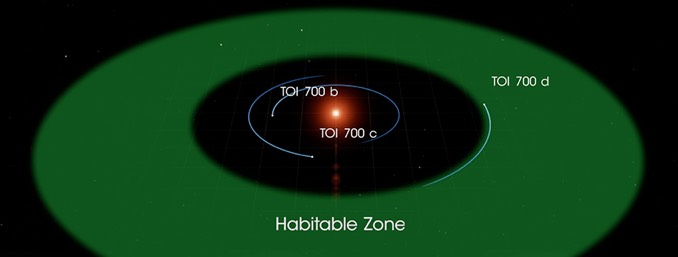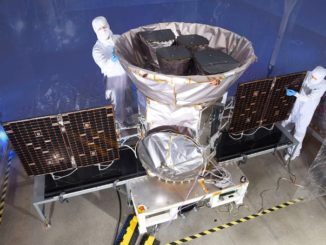
NASA’s Transiting Exoplanet Survey Satellite, or TESS, has chalked up two firsts. The exoplanet-hunting spacecraft has spotted its first Earth-size planet orbiting in the host star’s habitable zone. It also has detected its first circumbinary planet, a world the size of Saturn that orbits two stars. Both discoveries were discussed during the winter meeting of the American Astronomical Society in Honolulu.
A Habitable-Zone World Slightly Larger Than Earth
The habitable-zone planet is one of three orbiting a star known as TOI 700, a cool M dwarf with roughly 40 percent of the Sun’s mass located about 100 light-years from Earth. The star initially was misclassified as similar to the Sun in size, which meant its three planets were thought to be larger – and hotter – than they actually are.
Several researchers, including high school student Alton Spencer, found the error.
“When we corrected the star’s parameters, the sizes of its planets dropped, and we realised the outermost one (TOI 700 d) was about the size of Earth and in the habitable zone,” said Emily Gilbert, a graduate student at the University of Chicago. “Additionally, in 11 months of data, we saw no flares from the star, which improves the chances TOI 700 d is habitable and makes it easier to model its atmospheric and surface conditions.”
The innermost planet in the TOI 700 system is almost exactly the size of Earth, completing one orbit every 10 days. The middle planet is nearly three times larger than Earth, orbits its star every 16 days and is likely a gas-dominated world. Both are too close to TOI 700 for water to exist as a liquid on their surfaces.
The outermost planet, TOI 700 d, is about 20 percent larger than Earth, takes 37 days to complete one orbit and receives about 86 percent of the solar energy Earth receives. All three worlds are tidally locked, meaning they rotate once per orbit, and only TOI 700 d is at a distance where temperatures would allow water to exist in liquid form.
A team of astronomers led by Joseph Rodriquez at the Harvard-Smithsonian Center for Astrophysics sought confirmation of the discovery from NASA’s soon-to-be-retired Spitzer Space Telescope.
“Given the impact of this discovery, that it is TESS’s first habitable-zone Earth-size planet, we really wanted our understanding of this system to be as concrete as possible,” Rodriguez said. “Spitzer saw TOI 700 d transit exactly when we expected it to. It’s a great addition to the legacy of a mission that helped confirm two of the TRAPPIST-1 planets and identify five more.”
A Planet Found Orbiting in a Binary Star System
Another high school student, working as an intern at NASA’s Goddard Space Flight Center, contributed to another TESS discovery. Reviewing TESS data in search of eclipsing binary systems as part of a citizen science project, Wolf Cukier was able to discern a change in a star’s brightness that indicated the transit of a planet as viewed from Earth.
“I was looking through the data for everything the volunteers had flagged as an eclipsing binary, a system where two stars circle around each other and from our view eclipse each other every orbit,” said Cukier. “About three days into my internship, I saw a signal from a system called TOI 1338. At first I thought it was a stellar eclipse, but the timing was wrong. It turned out to be a planet.”
Known as TOI 1338 b, the planet is about 6.9 times larger than Earth, orbiting a small M dwarf and a Sun-like star that eclipse each other every 15 days.
TOI 1338 b is the only known planet in the eclipsing binary system and it can only be “seen” when transiting the larger of the two stars. Complicating the discovery, the planet’s transits are irregular, occurring between every 93 and 95 days and vary in duration and depth due to the orbital motions of the two stars.
“These are the types of signals that algorithms really struggle with,” said lead author Veselin Kostov, a research scientist at the SETI Institute and Goddard. “The human eye is extremely good at finding patterns in data, especially non-periodic patterns like those we see in transits from these systems.”
The Kepler Space Telescope discovered 12 circumbinary planets in 10 star systems. TESS is expected to observe hundreds of thousands of eclipsing binaries over the course of its two-year mission, raising the prospect of many more circumbinary exoplanet discoveries.



